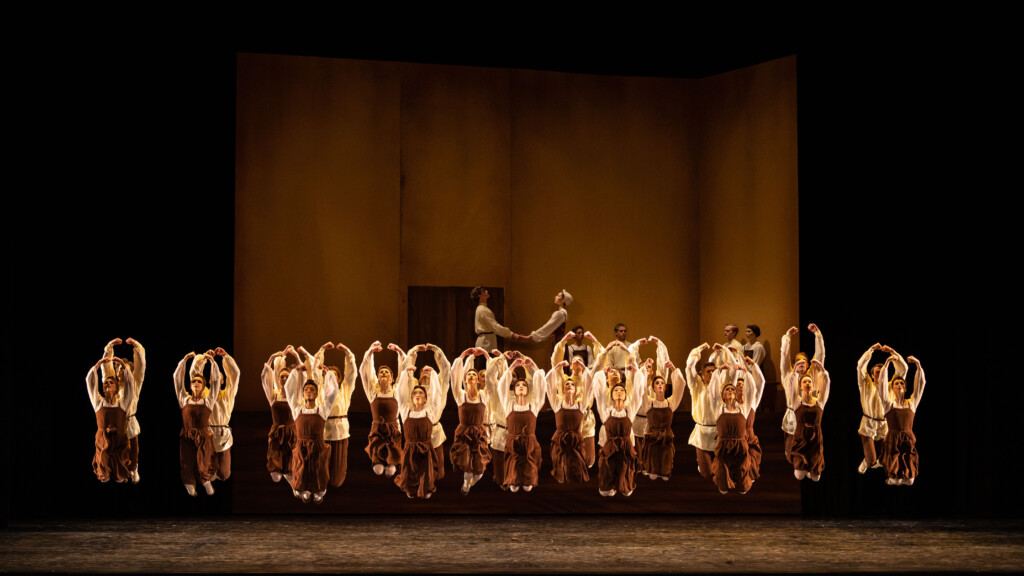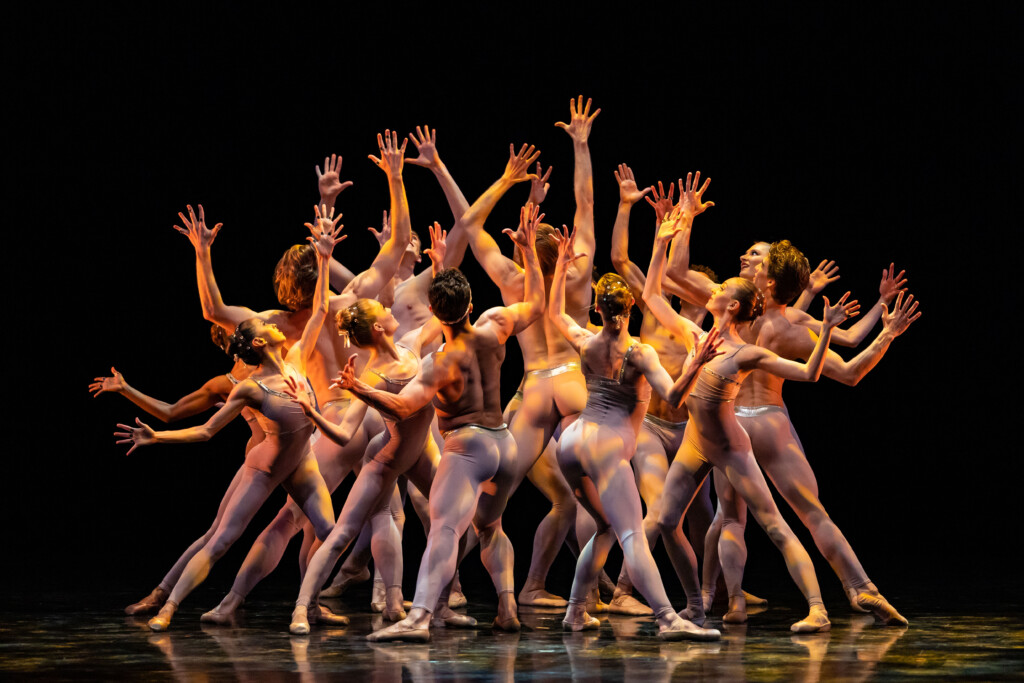With each work evoking its unique intricate, intuitive rhythmically reciprocal relationship between music and movement, the trio of Ballet West premieres in its most recent production proved to be the crowning highlight of the company’s superb 59th season.
A complex program of rigorous demands in all aspects, the presentation of Bronislava Nijinska’s Les Noces, Jerome Robbins’ In the Night and Gerald Arpino’s Light Rain was fascinating in its clever, retrospective thematic trajectory. Set to an extraordinary neoclassical score by Stravinsky, the opener, Les Noces (The Wedding), signified the transition where young people lament the inevitable passing of their innocent status but then move on to celebrate with their families and friends the new stage of matrimonial life. Robbins’ In The Night slyly subverts a quartet of pristine Chopin nocturnes in graceful dances merged with an erotic mind game of flirtation and courtship. Finally, with a taped soundtrack of music that feels like a fusion of the East and West but which is more like a bopping rock dance compilation, Arpino’s Light Rain is an ultra-sleek acrobatic uptake on whirling dervishes celebrating youthful, self-confident erotic bravura.
The Ballet West production of Les Noces, a work which premiered 100 years ago in Paris, was a stunner for viewer and listener. Set in four tableaux with a total running time of around 25 minutes, the work is rich and dense in its metaphorically ritualistic take on a folk village wedding. Leading the village of dancers are Victoria Vassos as the bride and Dominic Ballard as the bridegroom.
The formidable architectural neoclassical components of Nijinska’s choreography – which required dancers to perform on toe, for instance – symbolize many details in each of the four tableaus of the work, without becoming literal. The prevalent lamenting of the loss of innocent youth and its personality for both bride and groom, as well as the emotions experienced by their parents and friends, runs through the first three tableaux. Meanwhile, the formal movement structures make for a tour de force but also emotional celebration of their marriage, in the concluding tableau.
The musical accompaniment shined brilliantly, with Jared Oaks, Ballet West conductor, at the podium. Stravinsky scored the work for soprano, mezzo-soprano, tenor, bass, a chorus (with 26 voices for this production, with Jane Fjeldsted as chorus master), four pianos and percussion ensemble. This is a powerhouse pit, with singers Seth Keaton, Melissa Heath, Christopher Puckett and Jin-Xiang Yu, joined by pianists Ruby Chou, Nicholas Maughan, Whitney Pizza and Vedrana Subotic.
While the artistic possibilities of the folk wedding appealed to many of Stravinsky’s contemporaries, Stravinsky conceived the Les Noces score and its unprecedented instrumentation to be fully integrated into the atmosphere and contexts of the ritual celebration, which matched precisely to Nijinska’s choreography. For example, in the opening scene with the bride, Stravinsky had explained, her lament is manifested “not necessarily because of real sorrow at her prospective loss of virginity, but because, ritualistically, she must weep.”
The Ballet West’s production nails the premise accurately, even as some audience members might have expected a literal recreation of a Russian folk village wedding. Nijinska and Stravinsky were effective matches for a collaboration capturing an essence of a village ritual without necessarily providing concrete markers of its traditions. Stravinsky’s instincts about the primal and syncretic features of Russian folk music and his acknowledgment of its idiosyncrasies distinguishing one village from another, synced up with Nijinska’s broader intentions about choreographing a work such as Les Noces. As dance historian Lynn Garafola has noted in her definitive biography about the choreographer, in a 1932 interview in Paris with writer Jean Rollot, Nijinska said, “For me, dance is a rhythm. You know what rhythm is in music. Well, dance rhythm and music rhythm are not the same. Dance, music: two sisters with a ‘single’ existence. Two separate rhythms. The same thing in one harmony.”
After the awesome complexities of Les Noces, the four movements of Robbins’ In The Night were a refreshing palate cleanser for the audience. The three couples — Amy Potter and Hadriel Diniz, Emily Adams and Adrian Fry, and Katlyn Addison and Brian Waldrep — executed the juxtaposed elegance and mature awareness of flirtatiousness in their dances, to everyone’s delight. Maughan’s performance of the four Chopin nocturnes (Opus 27, no. 1; Opus 55, no. 1 and no. 2, and Opus 9, no. 2) synced up beautifully to the character of each scene.
Adams and Fry especially shined with the Russian-like dance gestures in the second movement and all three couples elucidated the best bits from the final movement, with the waltzing combos. Frankly, Robbins’ work (which the New York City Ballet premiered in 1970), while not in the same class of his other compositions, still offers more possibilities than George Balanchine’s Liebeslieder Walzer. To wit: Ballet West made this point quite handily.
Arpino’s Light Rain was an undisputed crowd pleaser. The choreographer’s most frequently performed work, it received its premiere in 1981 by the Joffrey Ballet for its 25th anniversary. The 14-minute work comes with a taped soundtrack of music by Douglas Adamz and Russ Gauthier.
One could hear the noticeable gasps and astounding responses to the incredible acrobatic and, yes, sexual energy of the piece during the performance, which highlighted soloists Emily Adams and Hadriel Diniz and a dozen other dancers. When the work premiered in 1981, Anna Kisselgoff of The New York Times described it as one of the “slickest efforts in the pop-erotic genre and it is mighty good slick.” That assessment holds for its 2023 Utah premiere.
While the work is typically described as a fusion of the East and West, Light Rain is unapologetic about its loose-fitting nature which eschews being viewed critically for whether or not its cultural appropriation might be true to its origins. The work was created amidst a restless era of New Age philosophy explorations. Also, disco and pop music had given way to new waves of electronic and synth pop and rock, along with trance and ambient music influenced by Sufism and other Eastern traditions.
It is precisely the sort of romp needed periodically on the ballet stage. Light Rain lets the athletically gifted dancers flex their prowess and artistic credentials. They are the core of a dynamic company which has ripened to the point where it can pull off successfully a wholly rigorous production like this, which happened to start with an impressive rendering of Les Noces.
Performances continue through April 22. For more information and tickets, see the Ballet West website.





3 thoughts on “Nijinska’s Les Noces (The Wedding) becomes crowning achievement for Ballet West’s superb 59th season”